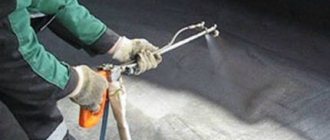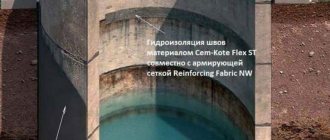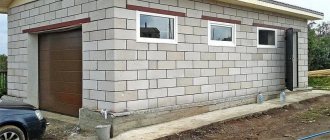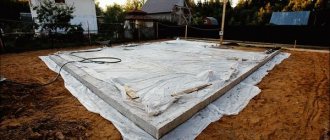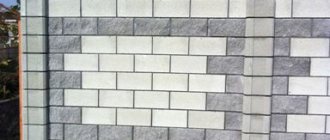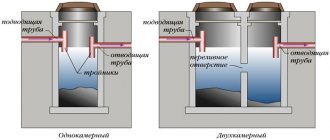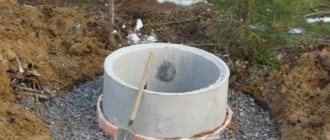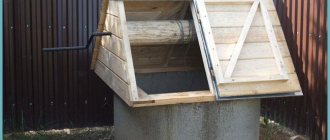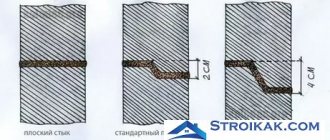The use of concrete rings for constructing wells for various purposes is a classic method that has been used for decades. It is built on the fact that separate concrete rings are installed on top of each other in a shaft dug in advance. The result is a fairly strong hydraulic structure, the only weak point of which is the joint sections between the rings. Waterproofing of a well made of concrete rings is carried out separately, using special materials and technologies. If this procedure is not followed, the concrete shaft will gradually collapse. If we are talking about a drinking well, then the quality of the water will be low due to dirt penetrating from outside.
Unclosed cracks in the well and dirt getting into them will significantly reduce the quality of drinking water Source yamoburoff.ru
Types of wells
A well is an indispensable attribute of a suburban, rural, or summer cottage site. There are three types of wells according to their purpose:
- Wells for drinking water. Over time, the walls of the well gradually lose their waterproofing properties and particles of soil and clay, products of agricultural and other activities, ground salts and much more get into clean water. This is why wells of this type require very high-quality external waterproofing.
- Sewer well or septic tank. In this case, the hydraulic protection should work differently - to prevent contamination of the soil surrounding the well.
- Technological (dry) well for servicing the water supply and sanitation system. We can say that these are a kind of technical rooms in which various systems, for example, water supply, are located. There should be no moisture in such wells and there should be high-quality waterproofing both inside and outside.
Each of the three types of wells must have completely sealed walls so that external moisture from the upper soil layers does not get inside, or vice versa - contaminated water from the septic tank does not seep into the ground.
To do this, it is imperative to waterproof the well, especially if it is built of concrete rings. Otherwise, water exchange will occur through the circular seams between the rings.
Drinking well
If these requirements are not met, the consequences can be very unpleasant - from poisoning with poor-quality water to contamination of water-bearing levels, surrounding water bodies, or failure of water supply equipment.
Waterproofing for a drinking well excludes the most effective materials, for example, bitumen-polymer mastics, as they give the water an unpleasant taste and are potentially hazardous to health.
If you plan to place a septic tank and a drinking well on your site, please note that the distance from the well to the septic tank must be at least 15 meters. The most important thing is that the septic tank is located below the well according to the terrain.
How to prevent well rings from moving in the future
The reason for the movement of concrete structures is weak soils, so before starting construction you need to determine the type of soil on the site. To prevent elements from moving horizontally, reinforced concrete modules with locking connections can be used instead of rings.
To save money, you can take standard concrete structures, make holes in them with a drill, and then drive in metal brackets, with their help you can connect the rings to each other. If they are not there, you can install metal plates, but they are placed on 2 sides. Bolts are used for fixation; their diameter must be at least 12 mm.
If the site has heaving soils, then the concrete elements are installed so that the bottom one is located below the freezing point. Instead of cylindrical modules, it is better to use conical ones.
Reasons for possible leaks in concrete wells
Water can penetrate into the well or from the inside out not only through the seams between the rings. Also problematic is the place where the pipe enters, leakage through poorly executed bottom waterproofing, or cracks that may arise, which can be caused by improper installation, poor-quality concrete, or temperature changes in winter. Another common cause of leaks in concrete sewer wells is a constant aggressive environment, due to which the concrete gradually breaks down and moisture leaks out.
Therefore, waterproofing the well must be done both from the inside of the walls and from the outside.
Waterproofing a well made of concrete rings
External waterproofing of a well
Sealing the walls of wells from the outside is done the same for all types. External waterproofing of the well is carried out to the upper edge of the well.
Preparation work can be carried out at an air temperature of at least + 5 degrees.
It is most convenient to install waterproofing of a well from the outside during the construction stage. Otherwise, you will have to carry out a significant amount of excavation work and completely open the walls of the well.
External waterproofing of seams of concrete well rings
Surface preparation
It may also be necessary to dig a well when performing repair work. The depth of soil removal should be at least 3-4 meters.
An existing well must first be drained. Draining the walls of the well is carried out until the dark spots on the concrete disappear. In rainy weather, the well must be protected from precipitation.
Loose concrete should be removed using a chipper. The outer surface is thoroughly cleaned: dirt, overgrown moss, salt deposits, etc. are removed. If metal parts are exposed when cleaning the surface, they must be carefully treated - remove rust and cover with an anti-corrosion solution.
Around places where there are seams and cracks, at a distance of up to 2 cm, it is necessary to make a recess in the concrete to a depth of about 2.5 cm. This will increase the area of contact of the concrete surface with the sealant.
External waterproofing of the well with bitumen mastic
Plaster under pressure
Pressure plaster is also used for internal and external waterproofing. Non-shrinking waterproof cement is supplied under high pressure created by compressed air. The sealing layer is uniform and dense.
The use of this method is not always justified due to considerable financial costs. To implement it, you need to have a special device, the so-called “cement gun”. The work is carried out at a temperature of at least +5 degrees C, 2 layers are laid, the thickness of each is from 5 to 10 mm.
To apply the next layer, you have to wait until the previous one has completely set, and this sometimes takes up to 2 weeks. To prevent cracking of cement on a hot day, it is moistened every 3.5 hours. In cool weather, the interval is increased to 12 hours.
Applying plaster under pressure to the walls of a septic tank is not practical from an economic point of view. Renting equipment to perform the work will significantly increase the cost of the structure
Waterproofing with bituminous materials
For external waterproofing of a well, roll bitumen materials and bitumen mastics are most often used.
- The initially prepared surface is coated with a primer to ensure good adhesion. For wells with drinking water, you must use a ready-made safe composition (for example, a primer composition like “Betokontakt”). For technological and sewerage structures, you can use a composition of 1 part bitumen and 3 parts gasoline.
- If you want to make very high-quality waterproofing, then additionally the seams can be taped with a special bentonite-rubber tape or CeresitCL 152 tape.
- After the primer has dried, repairs to the concrete rings begin: cracks, chips and potholes are repaired - the surface should be as smooth as possible. To fill the voids of damaged concrete rings, a cement mortar or a cement-sand composition with the addition of PVA glue in a ratio of 5 to 1 is useful.
- After the cement has dried, the surface is primed again.
- The next step will be the actual installation of waterproofing. To do this, the walls of the well are coated with tar mastic, since bitumen tends to crack.
- Then roll waterproofing is glued in 3 layers, no less.
- Next, all seams and joints of the insulating material are treated with mastic and the soil around is filled up. After its subsidence, a blind area must be made around the concrete well.
This work must be performed with respiratory protection, and then the well must be well ventilated.
Waterproofing "Penetron"
Technology of applying a protective layer
Waterproofing a well made of reinforced concrete rings can vary significantly depending on the time of its implementation. So at the stage of constructing a tank, preparation consists only of cleaning the surface from dust and various contaminants.
When working with an existing well, it is necessary to ensure that the tank is completely emptied, dried and cleaned. When doing waterproofing and treating seams with your own hands, it is best to choose the simplest protection methods, for example, mastics and coating materials, as well as their combination with membranes.
Surface preparation
After draining the well, its entire surface is cleared of old waterproofing material, as well as residual soil, sand and dust. To improve the adhesion of the selected composite, the entire area of the tank can be coated with special primers.
The distance between adjacent rings is cleared of old mortar and additionally primed. We must not forget that it is at the joints that the main leakage of wastewater or seepage of surface water into the tank can occur.
During the first treatment, you only need to thoroughly clean the surface of the entire tank and additionally prime it.
Application of insulating composites
Any coating material is applied in 2 or 3 layers, ensuring their reliable fastening due to additional reinforcement with polyester fiber. For initial application, 4 parts by weight of gasoline, white spirit or other approved solvent per 1 part of mastic are introduced into the composite. The prepared material is best applied with a brush or roller.
2 - 4 hours after application, before complete polymerization, a reinforcing fabric is laid on the surface of the waterproofing and a second layer of composite is applied. It is no longer required to dilute it, so it is best to heat the mastic and apply it with a spatula. As a result, the second layer penetrates the first, and the polyester fibers ensure reliable fastening of the insulating material.
Membranes and films are produced with an already applied adhesive layer, so they only need to be pressed to the surface and smoothed to remove trapped air. Their fastening is carried out after the applied mastic has hardened, that is, 24 hours after applying the coating composites.
Most often, membranes are used to protect the inner surface of the well from the emission of organic substances from the waterproofing layer. This treatment is necessary for tanks providing water supply.
Protection of seams and joints
The seams are treated before applying a layer of waterproofing over the entire surface of the well. After assembling the individual rings, the seams are additionally sealed with a classic solution of 1 mass part of cement and 3 parts of sand with the introduction of 1 - 2% liquid glass or 0.1% organosilicon water repellent. This treatment provides additional protection for the space between the rings.
Holes for water pipes are processed at the very end. Waterproofing of these elements is carried out in several stages, after installing the couplings.
Base insulation
Sewage wells for receiving wastewater and primary sedimentation must be additionally protected at the base
It is important to waterproof and seal the seams exactly at the junction of the first ring and the concrete pedestal
Attention to the foundation will avoid drainage leaks and protect the soil and groundwater from contamination by pathogenic bacteria
Carefully executed well protection will ensure long service life of the entire structure, and will also significantly simplify its maintenance.
Application of penetrating waterproofing
An alternative to bituminous materials is deep penetration waterproofing. This could be Penetron or the cheaper composition Elakor-PU Grunt-2K/50. In this case, there is no need for priming. In this case, the walls must be well moistened and the composition applied. After completing the application of deep penetration waterproofing, it is necessary to coat the entire surface again with waterproofing material and leave for 3 days, periodically moistening it according to the instructions.
When using penetrating waterproofing, it is very important to strictly follow the manufacturer's instructions. Different waterproofing compounds have their own characteristics and are applied in different ways.
Construction of a clay castle around a well
Use of polymer membranes
Polymer membranes are thin elastic films with an adhesive surface. Such waterproofing is much less commonly used due to its relatively high cost. The polymer membrane coating creates an elastic, waterproof layer that is resistant to temperature changes and prolonged exposure to moisture from the soil.
This method of waterproofing is used only for external treatment of rings. In addition to the high cost, the second disadvantage of polymer membranes is the need for careful leveling of the surface. And this is not easy for a well that was built a long time ago. For additional protection of seams, penetrating treatment or waterproofing mastics are usually used.
Purpose – treatment of external surfaces.
Construction of a clay castle
Waterproofing a well is a complex undertaking, so it would also be a good idea to build a so-called clay castle around the well. Its essence is that clay is laid along the perimeter of the external concrete walls. The purpose of the clay castle is to protect the well shaft from the penetration of surface and waste water.
A clay castle is not needed if there is stone, sand, or peat after the fertile soil layer. In this case, only rain and melt water must be drained, which in turn prevents surface water from entering directly into the storage part of the well.
Preparing clay for a clay castle
Experts recommend making a clay castle at the end of May. After the soil near the walls of the well has settled and dried out a little, you can move on to the final stage of constructing the well.
The clay castle is made to a level just above ground level. You can lay tiles or crushed stone on top around the well.
Work on arranging a clay castle should be carried out in dry, warm weather. In this case, the soil most often used is the one that remained during construction. The clay must be selected very carefully: there should be no stones or sand.
Initially, the top fertile layer of no more than 1-2 m around the well is removed. Tamping is carried out in several successive stages. Each stage consists of creating a thin clay layer with a slight slope in relation to the walls of the well.
The clay is wetted and firmly compacted into a small ball that fits in the palm of your hand. So, ball by ball, the clay is laid along the walls and pressed tightly. Such clay does not allow water to reach the walls, but causes it to flow to the sides.
In order for the laying of clay to be carried out with maximum effect, the thickness of each layer should be maintained at 12-15 cm. The initial layers of clay must be compacted very well. The dimensions of the clay castle should be in the range of 2 to 3 meters from the walls of the well.
Video: clay well castle
Concrete blind area
If you rush to concrete the area around the deck without waiting for the soil to shrink, then in 2-3 years the water in it will be cloudy during floods and after each rain. Your well will turn into a drainage well. If the clay lock of a well is broken, then in a few years it will be simply dangerous to drink from it.
Arrangement of a concrete blind area around the well
It is strictly forbidden to make a concrete blind area without building a permanent clay castle!
Internal waterproofing of a well
Internal insulation is carried out after the well is built and the bottom is installed. If you need to seal an old well from the inside, then the water must be pumped out and the concrete walls must be thoroughly dried, since most insulation materials must be applied to dry surfaces.
The work can be performed using the following waterproofing compounds:
- special cement putty;
- molten bitumen or bitumen-gasoline composition;
- cement-polymer mixture;
- bitumen-polymer composition;
- polymer waterproofing.
The first two methods are the cheapest, but they can only be used for concrete sewer wells. Compositions containing bitumen should never come into contact with drinking water.
If, during the preparation of walls for insulation from the inside, leaks of external water are observed, use the so-called hydraulic plug - an instant-hardening cement composition AQUAFIX or "Peneplug". This will allow you to perform all the necessary operations to waterproof the well efficiently.
AQUAFIX is a quick-setting hydraulic solution for instantly stopping water leaks, which has a flow rate of about 1.6 kg/l.
AQUAFIX hydraulic plug
“Peneplag” is a dry construction mixture that consists of special cement, quartz sand of a certain granulometry and patented active chemical additives. "Peneplug" is used to instantly eliminate pressure leaks in structures made of concrete, brick, natural stone and has a consumption of about 1.9 kg/l.
Technology of work execution
Preparatory work is generally similar to work for external waterproofing of a well: the well must be drained and kept dry throughout the entire period of repair work, the surface must be cleaned and prepared.
Joints, crevices and cracks must be carefully gouged to a shallow depth of 20-25 mm and thoroughly cleaned with a hard-bristled metal brush.
Coating waterproofing AQUAMAT-ELASTIC
All potholes must be repaired using a cement-polymer mixture and wait until the solution has completely dried, and then proceed to the final stage of work. At the end, it is necessary to cover the surface of the well with coating waterproofing in two layers. Follow the recommendations in the instructions for the material. Our experts recommend using the special composition AQUAMAT-ELASTIC from ISOMAT.
Conclusions and useful video on the topic
Here you will see how active leaks are repaired:
When using any option for waterproofing a septic tank, remember that the guarantee of obtaining a high-quality, durable coating is strict adherence to the technology. Do not neglect the manufacturers' recommendations regarding both the preparation of mixtures and their application.
Would you like to share a new product or effective method for sealing a septic tank? Did you have any questions on the topic or found any shortcomings in the presented material? Please write comments in the block below.
Review of materials
Cement mixture - there are ready-made dry mixtures on sale, which only need to be diluted with water according to the instructions and applied in several passes to form a layer of about 0.7 cm. The composition must dry for several days, so the surface must be moistened several times a day, and cover the well with a lid. The service life of such insulation does not exceed 15 years. For example, such mixtures are produced by the manufacturing company LITOKOL.
Bitumen-gasoline painting - the composition is prepared from their components in equal quantities. It must be applied in three layers with a break of 12 hours. Follow safety regulations. This option, like bitumen-polymer mixtures, is acceptable for use only in sewer wells. The service life is short - 5-10 years. Fused roll insulation can serve up to 30 years.
Cement-polymer mixtures are the most affordable of effective waterproofing materials. The best system today is the ISOMAT system. It includes the already mentioned AQUAFIX hydraulic plug, a modified repair composition MEGACRET-40 for sealing cracks and puttying joints and a finishing two-component elastic mixture of cement and polymer materials, which must be applied by coating in a layer of up to 0.3 cm. This composition is completely inert, environmentally friendly safe, does not affect water quality in any way.
Repair composition MEGACRET-40 for sealing cracks and puttying joints
The same high-quality result can be obtained using inexpensive non-shrink coating Penecrit or Penetron Admix. It is applied in 3 layers with a spatula. The service life of cement-polymer waterproofing is about 40-50 years.
A more expensive option is the two-component composition CeresitCR 166, which has increased elasticity. It should be applied in two layers, with a reinforcing fiberglass mesh placed on the first layer before it hardens. The service life of this waterproofing exceeds 60 years.
Polymer waterproofing mixtures are the most expensive, but also the most effective method, since polymer membranes, which are installed on special mastics, are very elastic. If your well is unstable, deformations and new cracks may appear, then you should not save money, but purchase polymer waterproofing. The most attractive price/quality ratio is for domestic products of the TechnoNIKOL brand. In this case, you will not be bothered by leaks in the well for at least 40 years.
Working with input
First of all, it is recommended to work out the entry of the pipe into the well. You can do this in several ways:
- Use of sealing kits. They are sold assembled, so you just need to assemble the insulation according to the instructions. The kit may include sealing gaskets, pressure disks, fittings, and adapters.
- The second method is to wrap the pipe with bitumen tape in several layers and fuse it to the concrete walls.
- Seal the pipe with cement mortar and polymer sealant.
Features of waterproofing a septic tank and a technological well
The design of a multi-chamber waste septic tank requires the presence of several successive wells. So, the last of them does not need to be waterproofed, because the essence of filtration is to ensure that the water goes into the ground as much as possible. Since it is an excellent biofilter, a small amount of wastewater will not cause harm. But, anyway, you should first consult with the environmental service - they may have their own restrictions.
But what the septic tank must be very carefully protected from is the ingress of rain and melt water. Therefore, it is necessary to very carefully seal all joints between elements.
Since the well must be completely dry for maintenance, both external and internal insulation must be performed.
Waterproofing well seams
For the construction of wells, rings with locks are usually used. A lock is a groove on the top and bottom of a ring. When the rings are lowered into the well, they stand on top of each other, which is called “groove in groove”, a kind of “lock” is obtained, thanks to which it is easier to align the shaft vertically, and it is more difficult for the rings to move to the side. The advantage of rings with a lock is that a strong and tight connection of the rings is ensured and there is no need to additionally seal the seams between the rings. However, it would not be a bad idea to cover the joint with cement mortar.
Waterproofing seams of concrete rings
Work should begin with insulating the bottom, then installing the ridge plate and the first ring. A special plate with a ridge is installed at the bottom of the well, which is needed for proper centering of the first ring.
Waterproofing of the joints of concrete well rings is carried out inside and outside. Between the rings (as well as between the first ring and the bottom), it is necessary to install a spacer cord (“Gidroizol M” or bentonite-rubber “Barrier”).
Inside, the seams can be waterproofed using the same coating waterproofing AQUAMAT-ELASTIC from the ISOMAT company, and outside using coating waterproofing on a bitumen or rubber base, as well as roll waterproofing, for example, the most common roofing material will do.
Video: waterproofing concrete well seams
Methods for increasing the moisture resistance of concrete rings
The following methods of waterproofing concrete wells exist:
- Constructive . Treatment of concrete rings using hydrophobic impregnations directly at the factory, after the products have hardened.
- Technological . The use of special techniques for compacting concrete poured into molds is envisaged. We are talking about centrifugation, vibrocompression and moisture removal using the vacuum method.
- Increasing the water resistance of cement . The resistance of concrete rings to moisture can be increased by introducing special water repellents into the solution. The specificity of the action of these substances lies in their swelling and clogging of pores and microcracks as the concrete hardens.
The use of these methods increases the cost of reinforced concrete rings. A cheaper option is to seal the walls and joint areas between the individual elements of the well shaft.
Sometimes it’s easier and cheaper to simply install hydraulic seals (cover up the internal joints), but no one can guarantee how effective and durable this will be. Source domvpavlino.ru
See also: Catalog of construction companies that offer design and installation services for water supply and sewerage.

